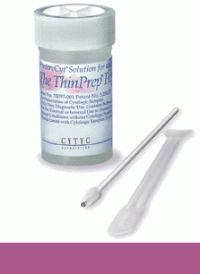ThinPrep® with Imaging and Aptima HPV® MRNA - Brush/Spatula
Main Content
| Test Code | Test Name | CPT Code |
| 58315 | Pap | 88175 (HCPCS: G0145) |
| 90934 | Pap, reflex HPV, if ASCUS (ages 21 and over) | 88175 (HCPCS: G0145) |
| 90933 | Pap and HPV (cotesting for ages 30-65) | 88175 (HCPCS: G0145), 87624 |
| 91339 | Pap and HPV, CT/NG (cotesting with STI risks) | 88175 (HCPCS: G0145), 87624, 87491, 87591 |
| 91414 | Pap & HPV mRNA E6/E7, reflex HPV 16,18/45 Genotype reflex when pap is negative and HPV is detected |
88175 (HCPCS: G0145), 87624 |
| Out of the Vial | ||
| 11361 | Chlamydia trachomatis RNA, TMA | 87491 |
| 11362 | Neisseria gonorrhoeae RNA, TMA | 87591 |
| 11363 | Chlamydia/N. Gonorrhoeae RNA, TMA | 87491, 87591 |
| 90521 | Trichomonas vaginalis RNA, Qualitative, TMA, PAP Vial | 87661 |
| 90569 | Herpes Simplex Virus, Type 1 and 2 DNA, Real-Time PCR, Pap Vial | 87529 (x2) |
Methodology: CYTYC Imaging System
Clinical Significance: Liquid Based Pap Testing is intended for use in the screening and detection of cervical cancer, pre-cancerous lesions, atypical cells and all other cytologic categories as defined by The Bethesda System for Reporting Results of Cervical Cytology. Pap screening is not reliable for the detection of endometrial cancer.
Additional Preferred Specimens Collection
ThinPrep Broom
Supply: C01 ThinPrep w/Brush/Spatula
Preferred specimen(s): Pap sample collected in Preservcyt, alcohol-based solution that serves as preservative, transport and antibacterial medium for gynecologic samples. For invitro use only.
Pap Test Lubrication Jelly Memo
Spatula Collection Instructions
1. Obtain an adequate sampling from the ectocervix using a plastic spatula. If desired, use lukewarm water to warm and lubricate the speculum. Water-soluble gel lubricant sparingly applied to the posterior blade of the speculum can be used if necessary.1 Select contoured end of plastic spatula and rotate it 360 degrees around the entire exocervix while maintaining tight contact with exocervical surface.
2. Rinse the spatula as quickly as possible into the PreservCyt solution vial by swirling the spatula vigorously in the vial 10 times. Discard the spatula.
Brush Collection Instructions
1. Obtain an adequate sampling from the endocervix using an endocervical brush device. Insert the brush into the cervix until only the bottommost fibers are exposed. Slowly rotate 1/4 or 1/2 turn in one direction. DO NOT OVER-ROTATE.
2. Rinse the brush as quickly as possible in the PreservCyt solution by rotating the device in the solution 10 times while pushing against the PreservCyt vial wall. Swirl the brush vigorously to further release material. Discard the brush.
Transport instructions for Brush or Spatula Collections
3. Tighten the cap so that the torque line on the cap passes the torque line on the vial.
4. Record the patient's name and ID number on the vial, and the patient information and medical history on the cytology requisition form.
5. Place the vial and requisition in a specimen bag for transport to the laboratory.
Transport container: Vials filled with Preservcyt
Transport temperature: Room temperature
Specimen stability for CT/NG 11363: Liquid cytology (Preservcyt® preservative (Thinprep®)
- Room temperature: 14 days
- Refrigerated: 30 days
- Frozen: not established
- Unlabeled vial
- Leakage of fluid during transport
- Mismatch between name of patient on vial and name on test requisition.
For additional supply or collection device information, please contact DLO's Customer Service at (800) 891-2917, option 2.
The CPT codes provided are based on AMA guidelines and are for informational purposes only. CPT coding is the sole responsibility of the billing party. Please direct any questions regarding coding to the payor being billed.
1 Cervicovaginal Cytology Based on the Papanicolaou Technique; Approved Guideline – Third Edition (Clinical and Laboratory Standards Institute GP15-A3).



CLIA